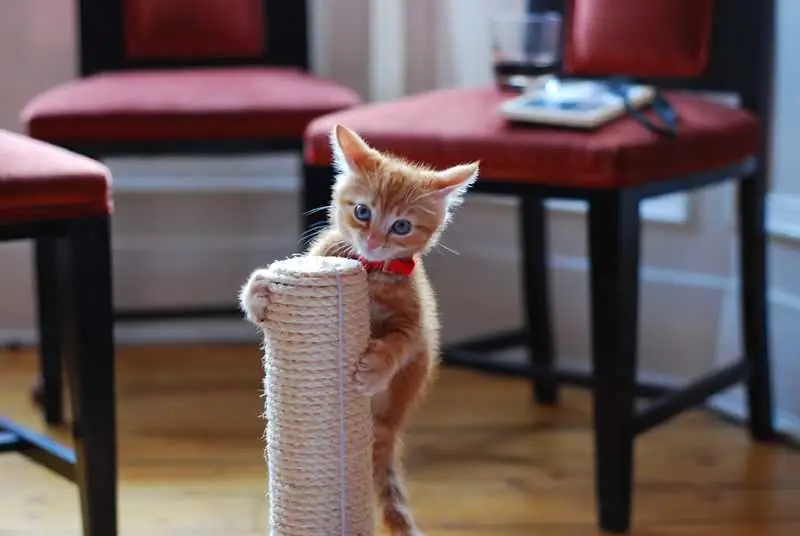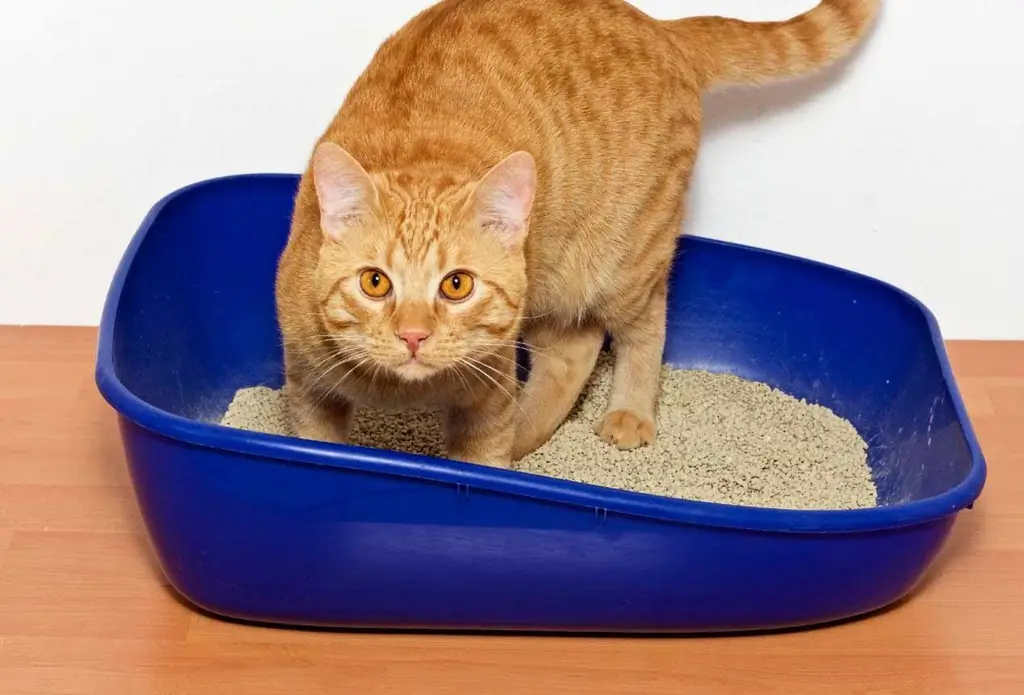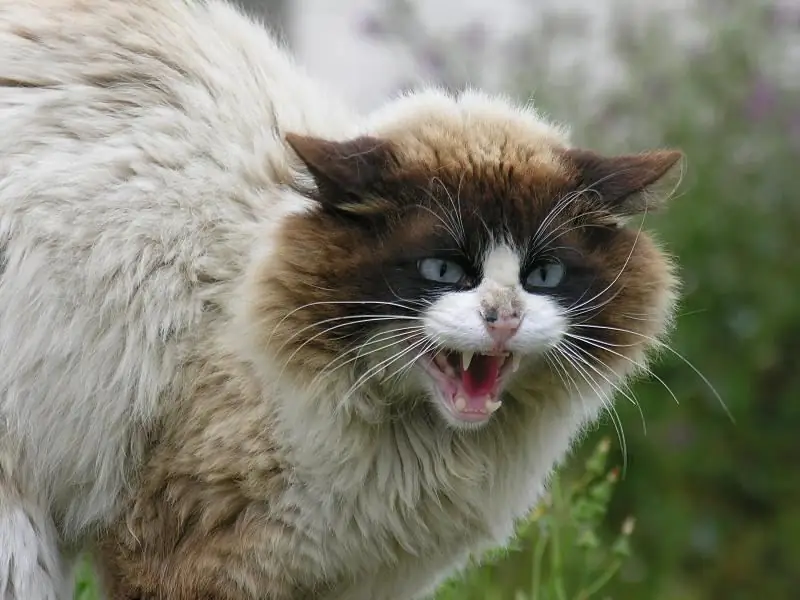
Table of contents:
- How to train an adult cat or kitten to a scratching post
- Why cats sharpen their claws
- How to prevent damage to furniture
- Varieties of scratching posts
- How to train your pet to a scratching post
- What to do if your cat doesn't want to use the scratching post
- Expert recommendations
- Personal experience of pet owners
- Author Bailey Albertson [email protected].
- Public 2023-12-17 12:53.
- Last modified 2025-01-23 12:41.
How to train an adult cat or kitten to a scratching post

The scratching post helps the animal realize instincts, and the owners save the wallpaper and furniture. If the pet is not provided with alternative options, he will choose a suitable surface on his own. Not the fact that this will suit the owners. Timely training to a scratching post allows you to prevent problems and get rid of possible conflicts.
Content
- 1 Why cats sharpen their claws
- 2 How to prevent damage to furniture
-
3 Varieties of scratching posts
- 3.1 Corner scratching posts
- 3.2 High scratching posts
- 3.3 Wall-mounted scratching posts
- 3.4 Columns
- 3.5 Scratching beds
- 3.6 Floor scratching posts
- 3.7 Play complexes
- 3.8 Scratching houses
- 4 How to teach a pet to a scratching post
- 5 What to do if your cat doesn't want to use the scratching post
- 6 Expert advice
- 7 Personal experiences of pet owners
Why cats sharpen their claws
Sharpening your claws is a natural instinct. It is vital for feral cats to keep their nails sharp and to an acceptable length. Pets, with proper care, could theoretically not monitor the condition of the claws, but they do it because of the preserved instincts. Sharpening helps not only to reduce the length, but also to learn how to release and retract nails in time. Pets need it to climb play complexes and other hills. Some cats have poor muscle control, which is why they spoil furniture when walking and accidentally scratch their owners.

Ingrowth of claws into the pads of the feet causes pain, suppuration, change in gait and deformity of the joints
Another reason for sharpening claws is stress and lack of physical activity. In the process, animals manage to throw out excess energy and emotions. In such cases, the pet behaves anxiously, can run around the house, jump on walls, etc. After sharpening the claws, the animal calms down or lies down to rest. Stress does not arise on its own, so you need to figure out the root cause: hunting for birds outside the window, the appearance of a new family member or pet in the neighborhood, moving and any other changes.

The house is a personal territory for the cat and helps to reduce stress, therefore, it helps to partially solve the problem of damage to property
In the process of sharpening claws, animals leave scent marks. This is due to the glands on the paws, which secrete an odorous secret. The need to mark the territory most often arises in older pets. Cats are more likely to sharpen their claws for this reason, although this behavior can also be observed in cats. Vandalism is more frequent when a new animal appears in the house or neighbors. In such cases, the old-timers are actively fighting for their territory and not only tear furniture, but also leave feces and urine. A similar thing happened with my sister: she got a second cat, and the first, despite having a scratching post and good manners, switched to wallpaper, sofas and carpets. The castration of both pets helped to solve the problem.
How to prevent damage to furniture
To prevent damage to property, owners often use anti-scratches - special pads for claws. Reviews about them are very different. Some argue that quality adaptations usually do not cause a negative reaction. Others ran into problems. My friend's cat gnawed off the caps and bit off several claws with them, bleeding opened. Of course, we managed to cope without a veterinarian, but I had to forget about anti-scratches. In more patient animals, gait may change due to discomfort. This entails the development of pathologies of the musculoskeletal system. In part, the reaction depends on the quality of the anti-scratches and their correct cutting, but sometimes even the original pads cause rejection in the cat, so it is better to do without a "manicure".

Manufacturers produce anti-scratch pads in different colors, but there is no fundamental difference for cats
Another reliable, but no less dangerous method is claw removal surgery. In the process, the specialist cuts out the entire phalanx along with the growth zone, which prevents tissue repair. This operation is inhumane, since later the animal suffers from pain in the area of the scars. If the tissues are normally protected by hard claws, then after removing the phalanges, the delicate shell can be damaged by granules of wood filler, sand, rough carpet surface, etc. Often cats after surgery refuse to use trays, which leads to new problems. If the animal, in addition, experiences stress, it may begin to gnaw on household items and furniture. It is strongly recommended to refrain from this method.
Clipping the claws helps to reduce the length and eliminate one of the causes of damage to property in the house. The cat does not have to sharpen its nails to prevent ingrowth. However, the need to protect the territory, hunting instincts, stress and the need for training persist, so the measure helps only in a quarter of cases. Even with shortened claws, the animal can leave marks on wallpaper and furniture. Cutting should not be forgotten as it avoids health problems, but this measure is not enough.

For cutting it is necessary to use special claws, which prevent the plate from delamination
A humane option is training to a scratching post. This is a kind of compromise: the cat retains the ability to realize instincts, and the owner does not have to regularly repair and change furniture. However, animals do not always readily agree with the new rules, so it is important to be persistent, explain to the pet what is required of him, and choose a scratching post that will appeal to the pet.
Varieties of scratching posts
First of all, scratching posts are divided into production and homemade. The latter are in no way inferior to the former, especially if the owner knows how to use tools, but even in the absence of experience, a simple design can be made. For example, a wall-mounted flat scratching post. Some cats prefer ordinary thick cardboard, but plywood and wooden fixtures covered with carpet, sisal or jute will look more aesthetically pleasing. It is advisable to experiment with the material in order to choose the coating that the pet likes best. Craftsmen can try to make a column or a whole play complex from PVC pipes, chipboard sheets and jute or sisal.
Corner scratching posts
Corner scratching posts can be several combined plates, a structure on a stand, a shelf with a wall covering, etc. In most cases, these are compact devices that will fit even in a small apartment. Cats especially like angular scratching posts with shelves: they climb onto them and observe the environment from above. However, tall pets are inconvenient to stretch out to their full height, and some pets can climb the wall or scratch it while already on the dais.

Corner scratching posts can be attached to external or internal corners
High scratching posts
High scratching posts can be produced in the form of standard elongated posts or with a house at the top. Such devices are suitable for large animals. Cats love to sharpen their claws, stretching out to their full height, and restrictions can cause them to move to walls and furniture. In addition, the structure with a house on the top relieves the animal from stress: the pet receives a shelter in which no one will disturb him, and the opportunity to observe what is happening from above. It is important to monitor the sharpness of the pet's claws so that it is not injured during the descent or ascent. For kittens and miniature cats, these scratching posts may not work.

High scratching posts are recommended for Maine Coon owners
Wall scratching posts
Wall-mounted scratching posts are vertical plates. They can be fixed on any flat surface and even used as a horizontal structure, if the pet likes it that way. Some owners place vertical plates on the sides of furniture to prevent vandalism. It should be borne in mind that after obtaining permission, the cat will tear other chairs and sofas, not seeing the difference. Wall scratching posts are well suited for those pets who often spoil the wallpaper.

Wall-mounted scratching posts can be connected to shelves
Pillars
A scratching post is a classic option. It differs from tall devices only in size and simplicity of design. Most animals like these claws, but to maintain interest, it is advisable to purchase non-standard models with toys, balls and other additions.

It is easier to teach a cat to posts with toys and feathers
Scratching beds
Scratching beds will appeal to lazy animals and those pets who like horizontal structures and carpets. Additionally, it is advisable to use such devices during training, since cats like to sharpen their nails immediately after sleeping. Scratching beds are compact: they can replace 2 pieces of furniture at once.

The main disadvantage of the scratching posts is the increased accumulation of wool on the surface due to the rough rough material
Floor scratching posts
Floor scratching posts are most often compact models with sisal or jute plates located at a slight angle. The key advantage of such models is the possibility of transportation and non-standard bending of the working surface. If the cat is not interested in other scratching posts, it is worthwhile to assume that she is on the floor: it is possible that she will like not vertical and horizontal plates, but a covering located at an angle.

Some designs consist of several scratching posts at once and can replace a small play complex
Play complexes
The game complex consists of several shelves, which are fastened together by posts with jute or sisal. The design can be supplemented with ladders, houses, hammocks, feathers, balls, etc. Play complexes serve as both a shelter, a toy, and a scratching post. They help keep the animal interested, avoid wall climbing, and reduce stress.

Gaming complexes take up a lot of space, so this option will not work with a limited area
Scratching houses
A scratching post house is another version of a compact design that can replace several pieces of furniture. The advantage of this device is that after sleep, the cat sharpens its claws more willingly. The design differs from the bench by the presence of a roof, because of which the animal feels safer, and the vertical arrangement of the post.

Scratching houses are compact, but not suitable for large animals due to the limitation in the form of shelves
How to train your pet to a scratching post
First of all, you need to decide on the location of the scratching post. Attention should be paid to the preferences of the animal: if the cat likes to tear carpets after waking up, it is advisable to put a horizontal structure near the bed, in case of damage to the wallpaper, you need to fix the plates with dowels and screws. You can leave scratching posts next to furniture that your pet is scratching. It is advisable to first use several designs, and later empirically choose the most beloved one and leave it alone.

In some cases, special sprays help to attract the cat's attention, but less radical methods are suitable for kittens.
In order for the cat to understand what needs to be done with the plates, you can set her a personal example: scratch your fingers on the surface. Many animals follow their owners. If the pet does not understand anything, you should carefully take it by the front legs, put them on the scratching post and slightly release the claws. You can simulate sharpening movements. In extreme cases, you can hope for an accident: put a scratching post near the beds and houses and wait for the pet to become interested in itself. Toys, feathers and balls help to attract the attention of the animal. When the cat starts to play, it involuntarily clings to the surface with its claws.
The pet should be actively praised for its interest, stroked and given treats. This is repeated every time the cat approaches or uses the scratching post. Soon the reflex is fixed, and the animal begins to associate pleasant emotions with the adaptation. Formed habits reduce the risk of damage to furniture.

The presence of a shelf in some cases speeds up the learning process: the cat has to climb and she quickly realizes that jute and sisal are tactilely pleasant materials that are easy to catch on
It is important to find an individual approach to each cat. Kittens quickly understand what is required of them if they are stimulated with toys or put their paws on a scratching post. For older animals who do not like tactile contact, it is better to set a personal example or lure them to the posts with fishing rods.
What to do if your cat doesn't want to use the scratching post
An adult cat can be punished for damaging furniture, but not for a lack of interest in the scratching post. It is allowed to eliminate motivation with the help of pungent odors or an unpleasant coating: scotch tape spread over the surface, wax strips, foil, applicators with thorns, etc. Animals are scared away by the aroma of citrus fruits, vinegar and essential oils.

Not all cats react in the same way to standard stimuli, so in each case you will have to look for an individual approach
You cannot beat the cat, as this will only increase the stress. As a last resort, you can use a spray bottle or noise trap from an empty tin and nuts or coins to prevent damage to property. The method should not be applied to kittens or weakened pets. Sooner or later, in the absence of alternatives, the pet will be interested in the scratching post. It is necessary to wait for this moment and begin to vigorously praise the animal.
Expert recommendations
Personal experience of pet owners
A scratching post is the only way to "negotiate" with a cat about damage to furniture. The device helps the animal to maintain its natural instincts and to relax in the event of lack of physical activity or the occurrence of stressful factors. However, the pet should be properly taught to the scratching post, avoiding the formation of negative associations, and choose a suitable model, otherwise the pet will prefer wallpaper and sofas.
Recommended:
Is It Possible To Soak Dry Food For Cats And Cats: Features Of Soaking For Adult Animals And Kittens, Recommendations Of Veterinarians

Is it possible and when it is necessary to soak dry food for cats and kittens, how to do it correctly, is it possible to store soaked food. Veterinarian recommendations
How To Train A Cat Or Cat To The Litter Box: Is It Possible To Quickly Teach Kittens And Adult Animals To Go To The Toilet In An Apartment, Veterinarian Advice

An overview of the types of toilets for cats, placement options. Description of fillers. Methods for training kittens, adult cats. Reviews, photos
A Cat Or A Cat Vomits With White Foam: The Reasons For Such Vomiting In Kittens And Adult Animals, Diagnosis And Treatment, Recommendations Of Veterinarians

Vomiting of white foam in cats, what can be caused. Additional examination methods for diagnosis. First aid, treatment. Preparations for the prevention of vomiting
How To Wean A Cat And A Cat To Tear Wallpaper And Furniture, Features Of Weaning Kittens And Adult Animals, Useful Tips And Tricks, Reviews

Why does a cat tear wallpaper and furniture? How to prevent damage to property. What to do if you can't wean your cat
Why Does A Cat Or Cat Meow Constantly, The Reasons For This Behavior In Adult Animals And Kittens, What To Do If They Walk Around The House And Yell At Night

The reasons why a cat or kitten meows constantly. How to deal with it. When do you need to urgently see a doctor?
